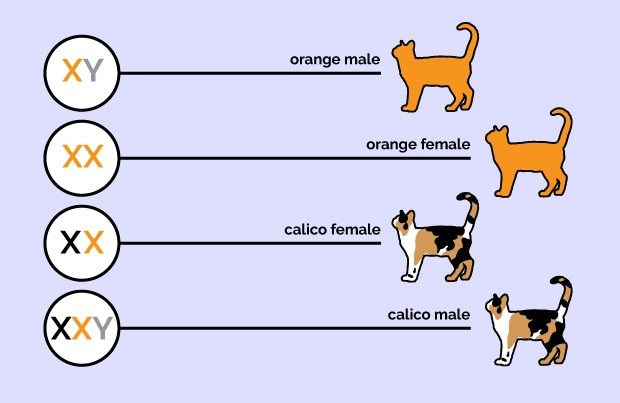Have you ever noticed that orange cats seem to be predominantly male? It’s not just a casual observation; it’s a fascinating quirk of feline genetics. You might be familiar with the stereotype of the female calico cat, and similarly, there’s a strong genetic basis for why you’re more likely to encounter a male orange tabby at your local animal shelter or even lounging in a sunny window.
But why is this the case? The link between a cat’s coat color and its sex is a captivating aspect of feline biology. While nature often presents exceptions to every rule, the prevalence of male orange cats is a well-documented phenomenon. Let’s delve into the science behind cat coat colors, explore the genetic mechanisms at play, and uncover why the world of ginger felines is largely dominated by males.
The Genetics of Cat Coat Color: Sex Chromosomes and Ginger Genes
To understand why orange cats are more often male, we need to revisit some basic biology. Mammalian sex is determined by two chromosomes: XX for females and XY for males. However, the story of coat color in cats goes beyond just these sex chromosomes. As Dr. Robert Grahn, a forensic analyst at the veterinary genetics laboratory at the University of California, Davis, explains, genes influencing traits like hair color, pattern, shape, and length are located on other chromosomes.
While these genes are generally inherited independently of sex, meaning coat color isn’t typically tied to gender in most mammals, cats (and hamsters) are an exception. This is because the genes responsible for orange and black coat colors are found on the X chromosome.
The foundation of feline coat color comes down to two primary colors: black and red (orange). These base colors can further diversify into various shades – black can mutate to chocolate, cinnamon, lilac, blue, and fawn, while red, governed by the orange gene, can become cream.
Crucially, the genes for these black and orange colors reside on the X chromosome, the very chromosome that dictates sex in conjunction with the Y chromosome in males, according to Dr. Jerold Bell, adjunct professor of genetics at Cummings School of Veterinary Medicine at Tufts University.
Dr. Bell clarifies that these color genes are alleles, meaning they are different versions of the same gene at a specific location on the X chromosome. An X chromosome can carry either the gene for black or the gene for orange, but not both simultaneously.
Dr. Susan Konecny, medical director for Best Friends Animal Society, further elaborates on the dominance of the orange allele. “One allele will create orange coloration. This allele will cover up all other colors, except pure white. The other allele will create a non-orange coloration. This allele is ‘recessive’ and allows for expression of a non-orange (usually black) coloration.”
This genetic setup is key to understanding the orange male cat phenomenon. Males, with their single X chromosome (XY), only inherit one allele for coat color from their mother. If they inherit the orange allele, they will be orange. If they inherit the black allele (or its variations), they will be black or another non-orange color. They cannot inherit both orange and black genes because they only have one X chromosome.
Females, on the other hand, possess two X chromosomes (XX). This means they inherit two alleles for coat color, one from each parent. This opens up the possibility of inheriting both an orange allele and a black allele.
 Cat chromosome chart
Cat chromosome chart
Understanding Cat Chromosomes: An illustration depicting the role of X and Y chromosomes in determining sex and coat color inheritance in cats.
Why Male Orange Cats are More Common: The Double X Factor
So, how does this genetic inheritance translate to the higher prevalence of male orange cats? Statistics indicate that approximately 81% of orange cats are male, according to Dr. Bell.
The reason lies in the fact that a female cat needs to inherit the orange gene on both of her X chromosomes to display an orange coat. In contrast, a male cat only needs to inherit the orange gene on his single X chromosome to be orange, as Dr. Konecny points out.
Dr. Bell explains further, “As the frequency of the orange gene is much less than the frequency of the black gene in the general cat population, the chance of having two orange genes is much less frequent. This makes male orange cats more frequent than orange females.” Essentially, it’s statistically less likely for a female cat to inherit two copies of the orange gene compared to a male inheriting just one.
This genetic mechanism also influences the coat color of kittens. If a mother cat is orange, all of her male kittens will be orange, regardless of the father’s color, as they will inherit her X chromosome carrying the orange gene, explains Dr. Konecny. If a mother cat is tortoiseshell (a mix of black and orange), half of her male kittens will be orange, inheriting the orange X chromosome, and the other half will be black, inheriting the non-orange X chromosome.
For a female kitten to be orange, both parents need to contribute the orange gene. Dr. Konecny clarifies that if both the mother and father are orange, all female kittens will be orange. If the mother is tortoiseshell and the father is orange, half of the female kittens will be orange, inheriting an orange gene from each parent.
Exceptions to the Rule: Female Orange Cats
While less common, female orange cats do exist. As explained above, they occur when a female cat inherits the orange gene from both her mother and her father. This is statistically less frequent than a male cat inheriting the orange gene from his mother, making female orange cats a delightful, but rarer, sight.
Understanding the genetics behind feline coat color not only explains the prevalence of male orange cats but also deepens our appreciation for the intricate beauty and diversity within the feline world. The next time you see a ginger cat, remember the fascinating dance of chromosomes and genes that painted its vibrant orange coat, and appreciate the slightly higher chance that you’re admiring a handsome male!

